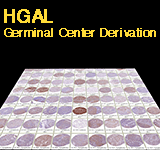
|
Expression of the Human Germinal Center-Associated
Lymphoma (HGAL) Protein, A New Marker of Germinal
Center B Cell Derivation
Yasodha Natkunam, Izidore S. Lossos, Behnaz Taidi,
Shuchun Zhao, XiaoQing Lu, Feying Ding, Anne Sofie Hammer,
Teresa Marafioti, Gerald E. Byrne Jr, Shoshana Levy,
Roger A. Warnke, Ronald Levy
Blood First Edition Paper, prepublished online January 27, 2005; DOI 10.1182/blood-2004-08-3112.
|
|
|
|
|
Home
|
-
Welcome to the web
supplement to the paper:
Expression of the human germinal center-associated lymphoma (HGAL) protein, A new marker of germinal center B cell derivation
-
Abstract:
We identified the Human Germinal center-Associated Lymphoma (HGAL) gene
in gene expression profiling studies of diffuse large B-cell lymphoma (DLBCL). The
expression of the HGAL gene correlated with survival in patients with DLBCL. The
HGAL gene is the human homologue of M17, a mouse gene expressed specifically in
normal germinal center B cells. Here we generated a monoclonal antibody against the
HGAL protein and show that HGAL is expressed in the cytoplasm of GC-lymphocytes
and in lymphomas of GC derivation. Among 718 lymphomas tested by
immunohistochemistry on tissue microarrays, HGAL staining was found in follicular
(103/107), Burkitt (40/40), mediastinal large B (7/8), and in DLBCL (103/151). Nodal and
extranodal marginal zone lymphomas lacked HGAL staining. Lymphocyte predominant
Hodgkin (12/17) and, surprisingly, classical Hodgkin (78/107) lymphomas were found to
be positive. Hierarchical clustering of comparative immunohistologic results in DLBCL
demonstrates that the expression of HGAL is similar to two other GC-associated
proteins BCL6 and CD10, but different from two markers associated with a non-GC
phenotype, MUM1/IRF4 and BCL2. The restricted expression and GC-specificity of
HGAL protein suggest that it may have an important role in the diagnosis of specific
lymphomas, and, potentially in the identification of subtypes associated with different
prognoses.
|
|
|
|
[ Home
| HGAL Images
| WebPortal
| Authors
]
|
